Embark on a culinary journey to the heart of France with our exquisite French Onion Soup Recipe! Dive into a rich, amber broth brimming with caramelized onions, their sweetness enhanced by a splash of wine. Each spoonful is a harmonious blend of savory and sweet, with a golden, bubbly layer of Gruyère cheese adding a luxurious touch. Garnished with a crispy baguette slice, this soup is a masterpiece in a bowl, promising a delightful dance of flavors with every indulgent sip.
On a chilly day, there’s something uniquely comforting about a bowl of my beloved french onion soup recipe. Its rich, savory broth envelops you in warmth while the sweet caramelized onions dance playfully on your palate.
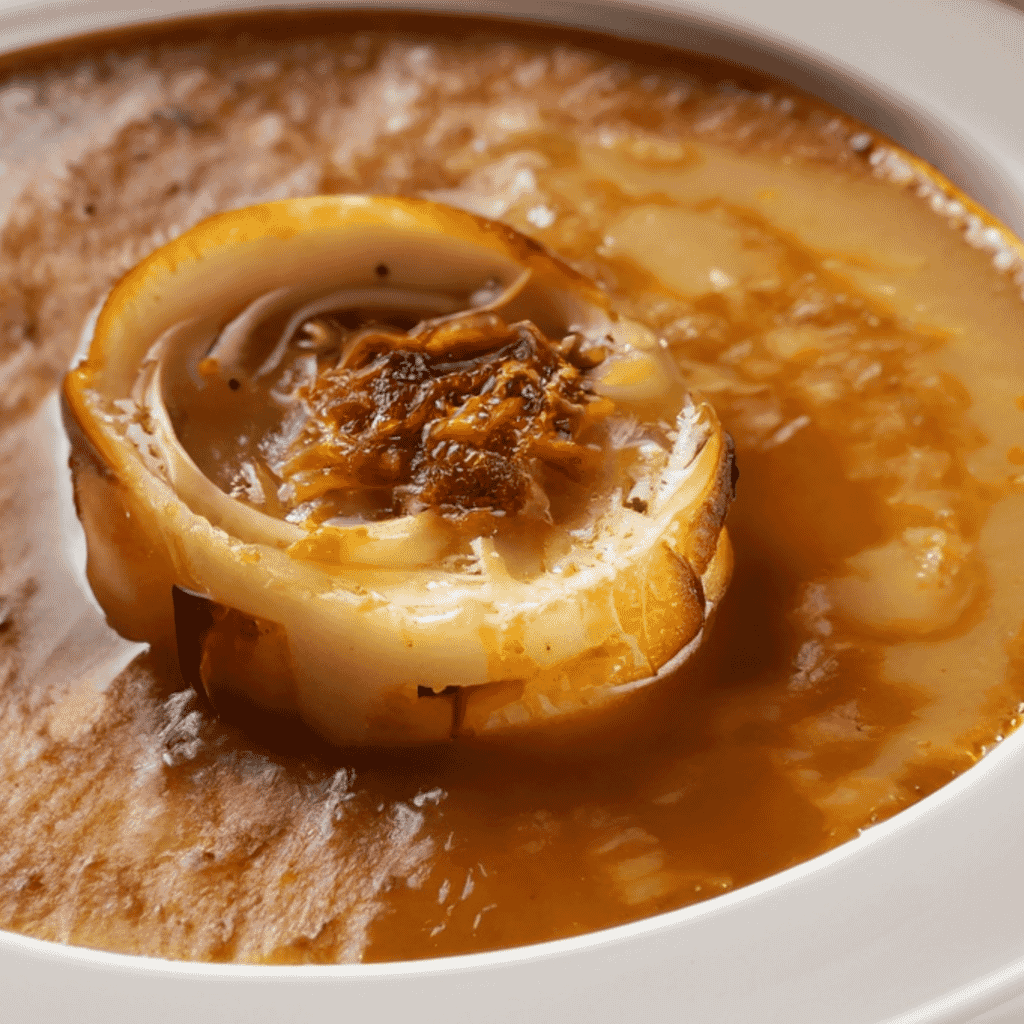
French onion soup is a rich and warming meal. The main flavors come from the caramelized onions and the intense beef stock.
If you have never had French onion soup, you might have thought it was vegetarian. Still, the most essential ingredient is beef stock. Without it, you cannot get the deep richness this soup is known for.
If you are vegetarian, scroll down to the bottom of our recipe. We have a unique ingredient to help you imitate the all-important beef stock.
What Is French Onion Soup?
French onion soup is a traditional dish from France, known for its comforting and rich flavors. It’s often considered a classic bistro dish and has become famous worldwide for its unique blend of simplicity and depth of taste.
At its core, French onion soup is an onion and broth-based soup, but the method of preparation transforms these simple ingredients into something extraordinary.
The essential process in making the soup is the caramelization of the onions. They are sliced and slowly cooked until they reach a deep brown color and develop a rich flavor.
Once the onions are caramelized, they are deglazed with wine, which lifts the flavorful bits from the bottom of the pan, adding another layer of complexity. Then, a savory broth, traditionally beef but sometimes chicken or vegetable, is added. The soup is simmered to let the flavors meld together.
What sets French onion soup apart is its iconic garnish. Each bowl of soup is topped with a slice of crusty bread and a generous amount of cheese, usually Gruyère. The soup is then broiled until the cheese is melted, bubbly, and slightly browned.
The result is a satisfying, hearty soup with a sweet and savory balance of flavors, contrasted by the crispy cheese topping and the tender-soaked bread. French onion soup is a testament to the transformative power of slow cooking and careful layering of flavors.
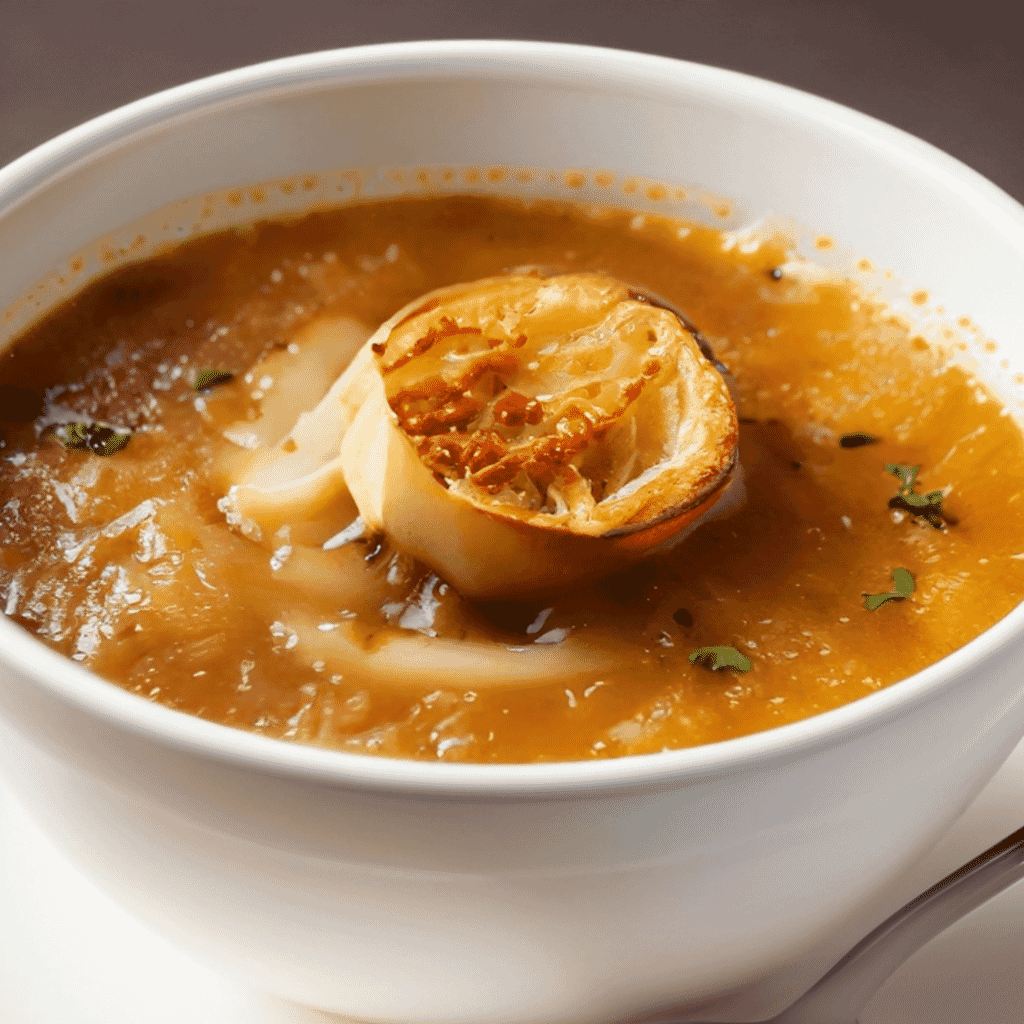
Can You Vary The Recipe With Other Ingredients?
You can vary the recipe for French Onion Soup to accommodate different dietary preferences or restrictions. Here are some modifications you might consider:
- Keto
You could substitute the sugar used in caramelizing the onions with a keto-approved sweetener for a keto-friendly version. Also, omit the bread or use a keto-friendly bread alternative.
- Paleo
Paleo adherents avoid grains, so you’d want to replace the traditional bread with a paleo-friendly version. Be sure to use a high-quality bone broth for added nutrients.
- Gluten-Free
The main component of French onion soup that contains gluten is the bread. Use gluten-free bread instead, and ensure your broth is also gluten-free.
- Whole 30
For a Whole-30 compliant French Onion Soup, you must omit the bread and the cheese. While this does change the character of the dish somewhat, the rich flavor of the caramelized onions and broth will still make for a satisfying soup.
- Vegan/Vegetarian
Substitute the beef broth with a robust vegetable broth and use vegan cheese or nutritional yeast instead of traditional cheese for the topping. Ensure the bread is vegan as well.
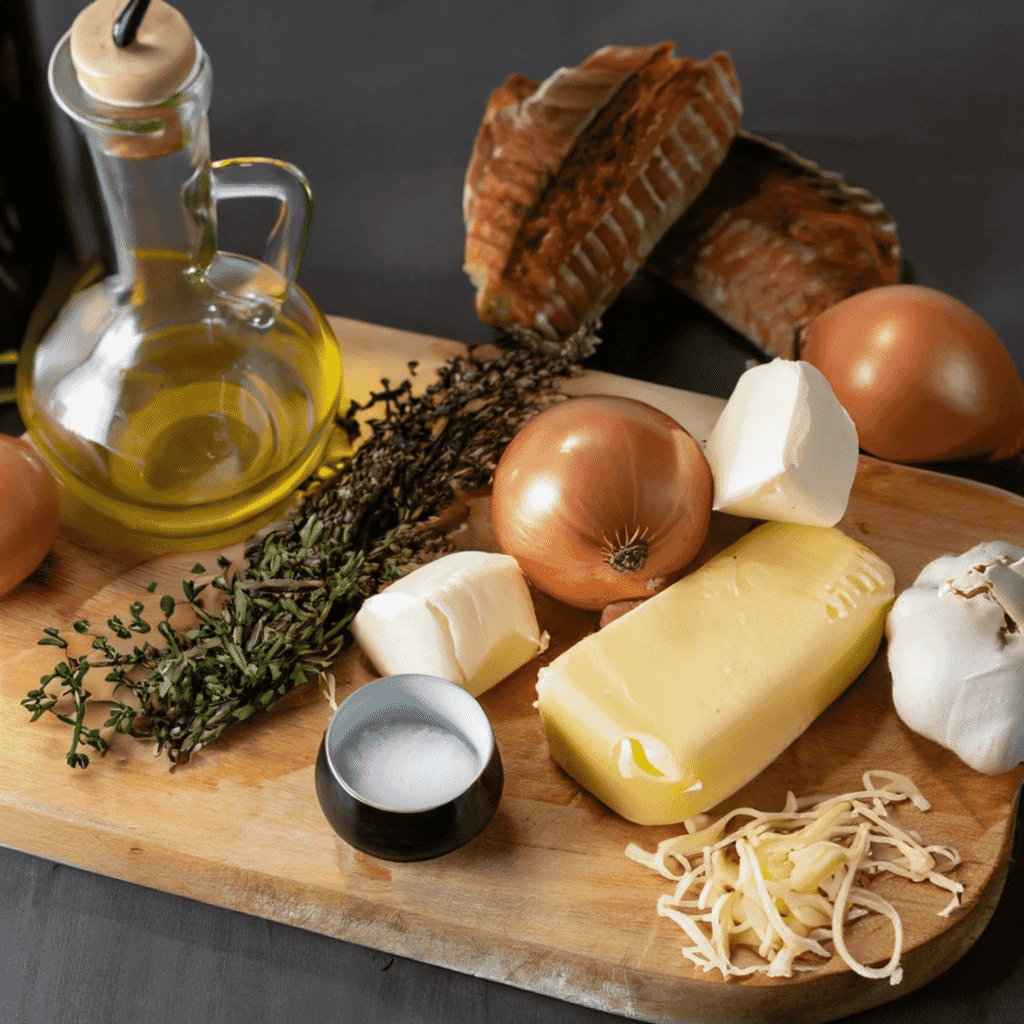
Recipe Directions
- Use a Dutch oven or heavy stockpot over low heat.
- Add oil and butter, then onions. Cook for 1 hour until soft and sweet but not brown.
- Add kosher salt and sugar. Cook for another 15 minutes.
- Pour in Vinegar and cook for 5 minutes to balance flavors.
- Stir in flour and cook for 1 minute to thicken the soup.
- Pour in wine to deglaze, then add beef stock.
- Bring to a boil, then simmer for 30 minutes to meld flavors.
- Season with salt and pepper to taste. Remove from heat and cover.
- Toast French bread slices, rub with garlic, and top with Gruyère cheese.
- Broil until the cheese is melted and golden.
- Ladle hot soup into bowls.
- Top with cheese-covered croutons.
- Serve hot and enjoy!
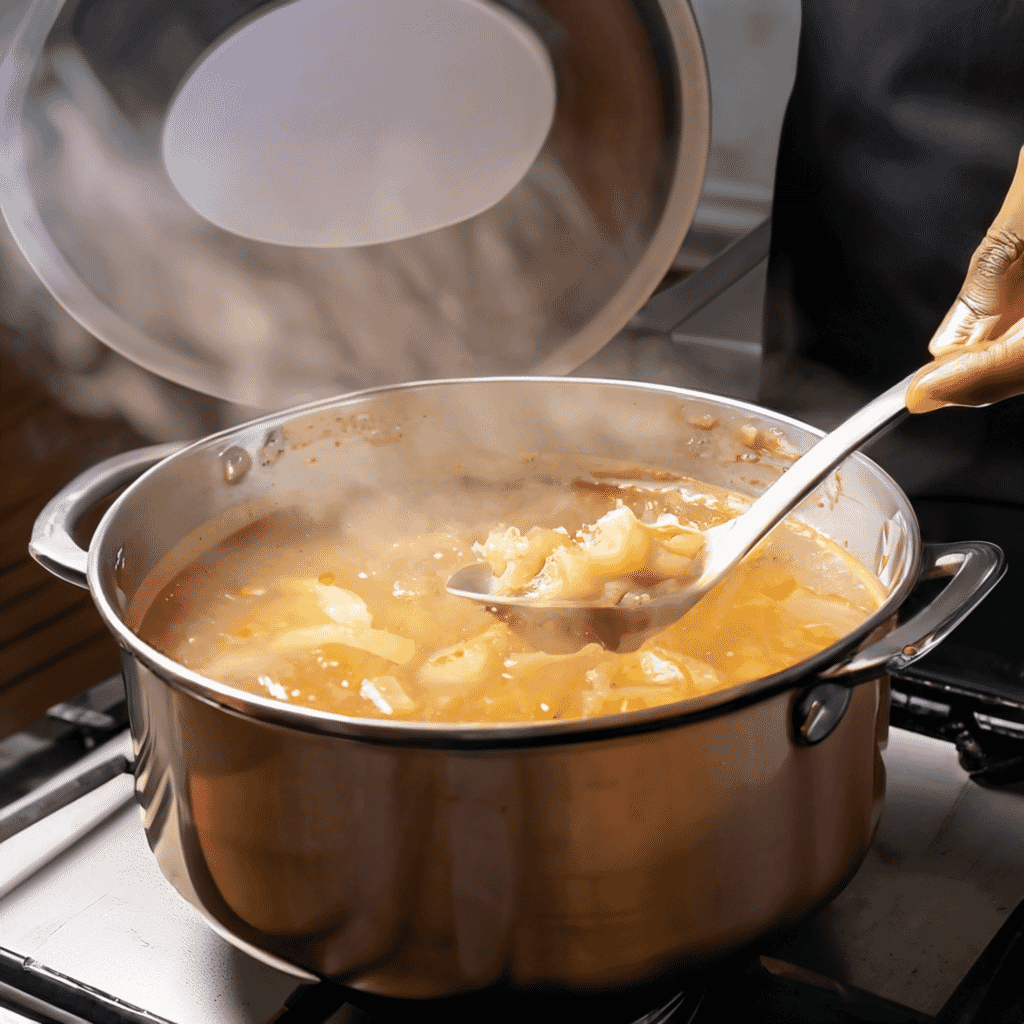
Variations, Add-Ons, And Toppings
- Different Cheeses: While Gruyère is traditional, you could try using other types of cheese that melt well, like fontina, provolone, or even a sharp white cheddar.
- Alcohol: Some people enjoy adding a splash of cognac, brandy, or sherry to the soup along with the wine for added depth of flavor.
- Herbs and Spices: A sprig of fresh rosemary or a bit of sage could offer a new dimension to the soup. A pinch of nutmeg or allspice could add some warmth and complexity.
- Garlic: Rubbing a cut clove of garlic on the toasted bread before adding it to the soup can give an extra flavor boost.
- Mushrooms: Adding some finely chopped sautéed mushrooms to the soup can provide a pleasant texture contrast and deepen the savory flavors.
- Croutons: Instead of a single slice of bread, you could top your soup with several smaller croutons.
- Roasted Garlic or Onion: Roasting an onion or a head of garlic and then adding it to the soup while it simmers can add a deeper, more caramelized flavor.

Can I Make Soup In A Slow Cooker Or Instant Pot?
Both a slow cooker and an Instant Pot can be excellent tools for making French Onion Soup. Here are the essential adaptations you would need to make:
Slow Cooker
- Start by caramelizing your onions in a pan on the stove as you normally would. This essential step develops the rich, sweet flavor that is the hallmark of French Onion Soup.
- Once your onions are caramelized, transfer them to your slow cooker along with the garlic, bay leaves, thyme, and broth.
- Set your slow cooker to low and let it cook for about 6-8 hours. This slow, gentle cooking will allow the flavors to meld beautifully.
- Before serving, prepare your bread by toasting it, then topping it with cheese and broiling it until melted. Add this to the individual bowls of soup right before serving.
Instant Pot
- Use the sauté function on the Instant Pot to caramelize your onions, adding in the garlic, bay leaves, and thyme towards the end.
- Once your onions are caramelized, add your broth to the Instant Pot, close the lid, and set the pressure to high. Cook for about 20 minutes.
- After the cooking time is up, use the quick-release function to release the pressure.
- Prepare your bread by toasting it, topping it with cheese, and broiling it until it is melted. As with the slow cooker version, add this to the individual soup bowls right before serving.
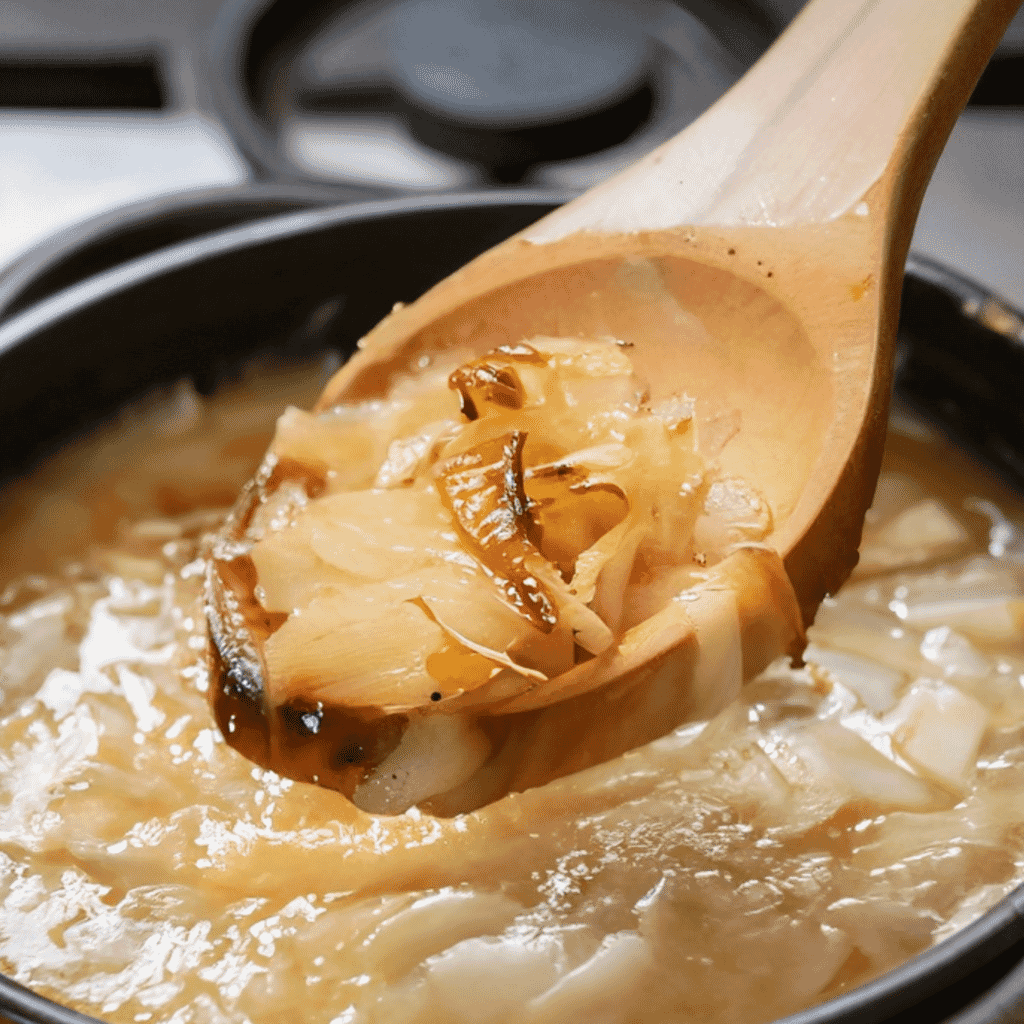
Can I Use Store Bought Broth Or Should I Make My Own?
While making your broth for French Onion Soup would undoubtedly give you a richer and deeper flavor, using store-bought broth is perfectly fine, especially when time or resources are limited. Here are some considerations:
Store-Bought Broth
Pros
- Convenience: It’s ready to use, saving you the time and effort of making your own.
- Consistency: The flavor and saltiness are consistent, which can help ensure predictable results.
Cons
- Less Flavorful: It may lack the depth and richness of homemade broth.
- Preservatives: Some brands contain preservatives or additives, which some people prefer to avoid.
- Sodium Content: Store-bought versions can be high in sodium. Look for a low-sodium version if you’re watching your salt intake.
Homemade Broth
Pros
- Flavor: Homemade broth is usually more flavorful and richer than store-bought.
- Control: You have complete control over the ingredients and the sodium level.
- No Preservatives: There are no preservatives or artificial ingredients in homemade broth.
Cons
- Time-Consuming: It can take several hours to make homemade broth.
- Inconsistent: The flavor may vary each time you make it, depending on the bones and vegetables used.
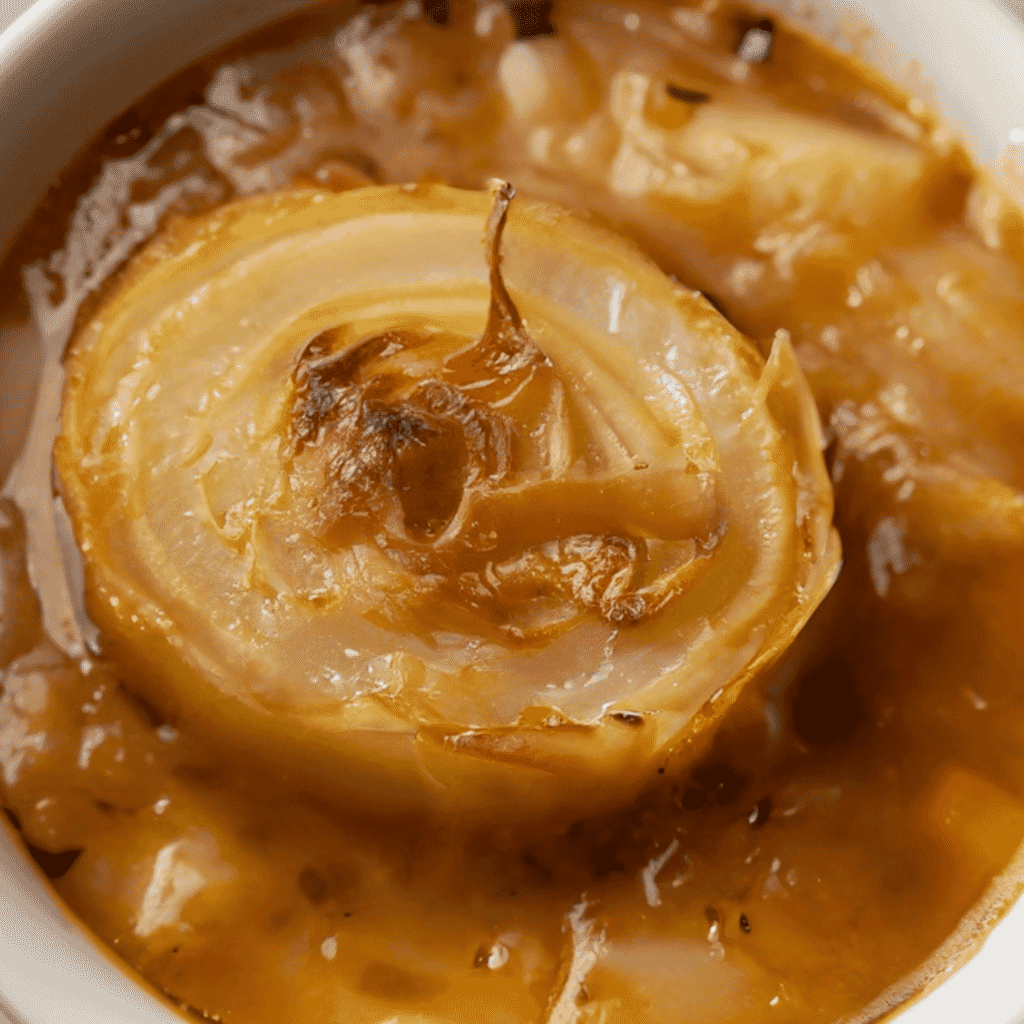
How To Serve?
Serving French Onion Soup can be a part of a memorable dining experience if done correctly. Here are some tips for serving it in the best possible way:
- Use Oven-Safe Bowls: French Onion Soup is traditionally served in individual oven-safe bowls or crocks. This allows the soup to be broiled right before serving, giving the cheese on top a delightful, crispy, golden crust.
- Garnish: While not required, you can garnish the soup with a sprinkle of fresh thyme, parsley, or chives to add a touch of color and fresh flavor.
- Serve Hot: French Onion Soup is best served right after broiling the cheese. Be careful, as the bowl will be hot.
- Serving Utensils: Provide soup spoons and extra napkins, as French Onion Soup can be a bit messy due to the melted cheese topping.
- Pairings: The soup is often served as a starter for a main course, but it can also be a meal on its own. Pair it with a fresh side salad or a hearty sandwich for a complete meal. A glass of white or red wine (like a Chardonnay or Cabernet Sauvignon) that complements the rich flavors of the soup could also be a great addition.
- Bread: If you’re not using bread as a topping, consider serving a warm, crusty baguette on the side. The bread is perfect for soaking up the flavorful broth.

Perfect Side Dishes
French onion soup is hearty and rich and pairs well with lighter, refreshing side dishes. Here are some suggestions:
- Salad: A crisp green salad with a tangy vinaigrette can help cut through the soup’s richness. A classic French salad with frisée lettuce, Dijon mustard vinaigrette, and perhaps a few lardons or a poached egg would be particularly appropriate.
- Roasted Vegetables: Lightly seasoned and roasted vegetables like Brussels sprouts, asparagus, or bell peppers can complement the soup well.
- Bread: Although the soup itself often comes with a slice of bread on top, a side of fresh, crusty French bread can be an excellent addition for those who love to dunk their bread in the soup.
- Quiche: A slice of a light quiche, perhaps with a vegetable filling, can pair nicely with the soup for a more substantial meal.
- Cheese Plate: A small selection of French cheeses, with some grapes or apple slices, could be an excellent way to continue the French theme of the meal.
- Charcuterie Board: A small charcuterie board with a selection of cured meats can provide a salty counterpoint to the sweet and rich soup.
- Fruit: For a light finish, serve some fresh fruit, like a refreshing citrus salad or a simple apple or pear sliced.
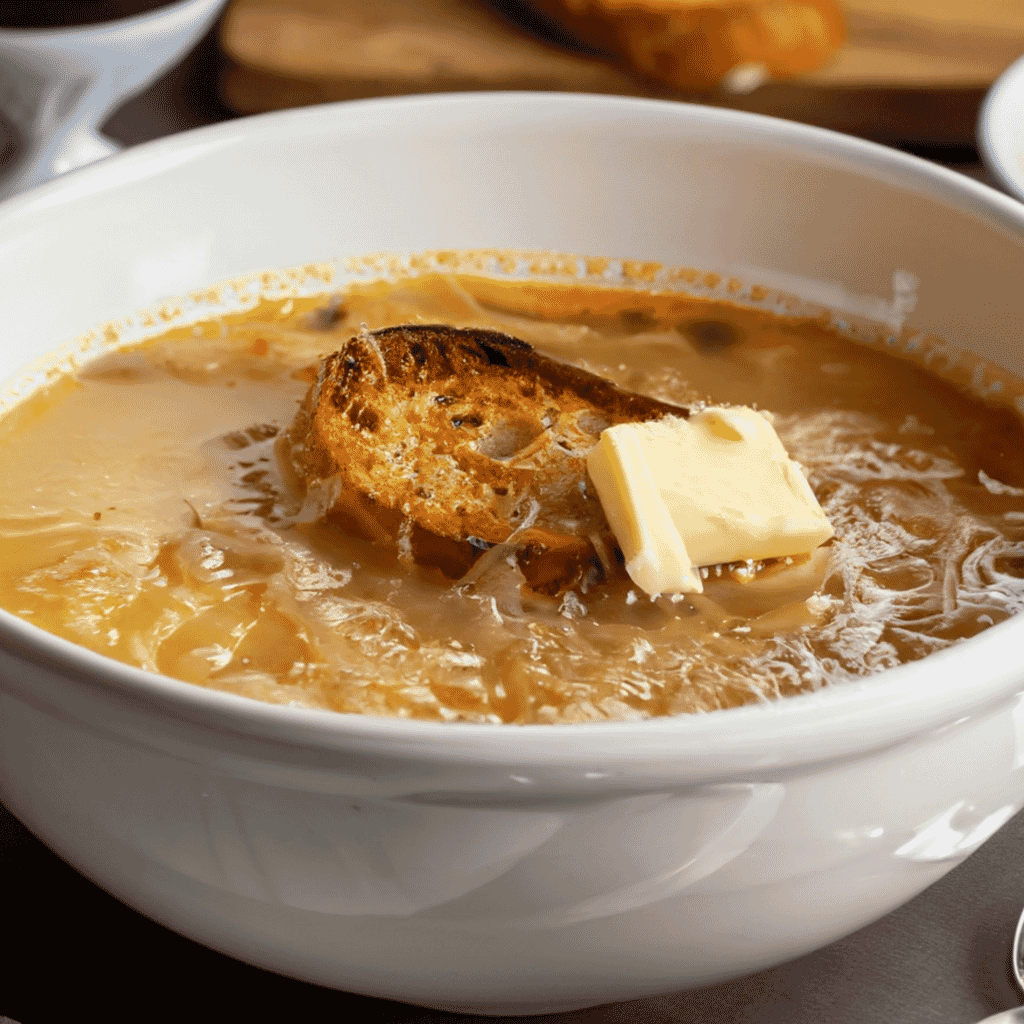
Storage And Make Ahead
- Cooling: Allow the soup to cool completely before storing.
- Refrigeration: Transfer the cooled soup into airtight containers and store in the refrigerator for up to 3 days.
- Freezing: French onion soup freezes well. Place it in freezer-safe containers or bags, leaving some room for expansion, and freeze for up to 3 months.
- Reheating: When ready to serve, reheat gently on the stove over low heat, stirring occasionally.
- Make Ahead: Prepare the soup entirely, excluding the bread and cheese topping, and refrigerate or freeze. Add bread and cheese just before serving for optimal texture and flavor.
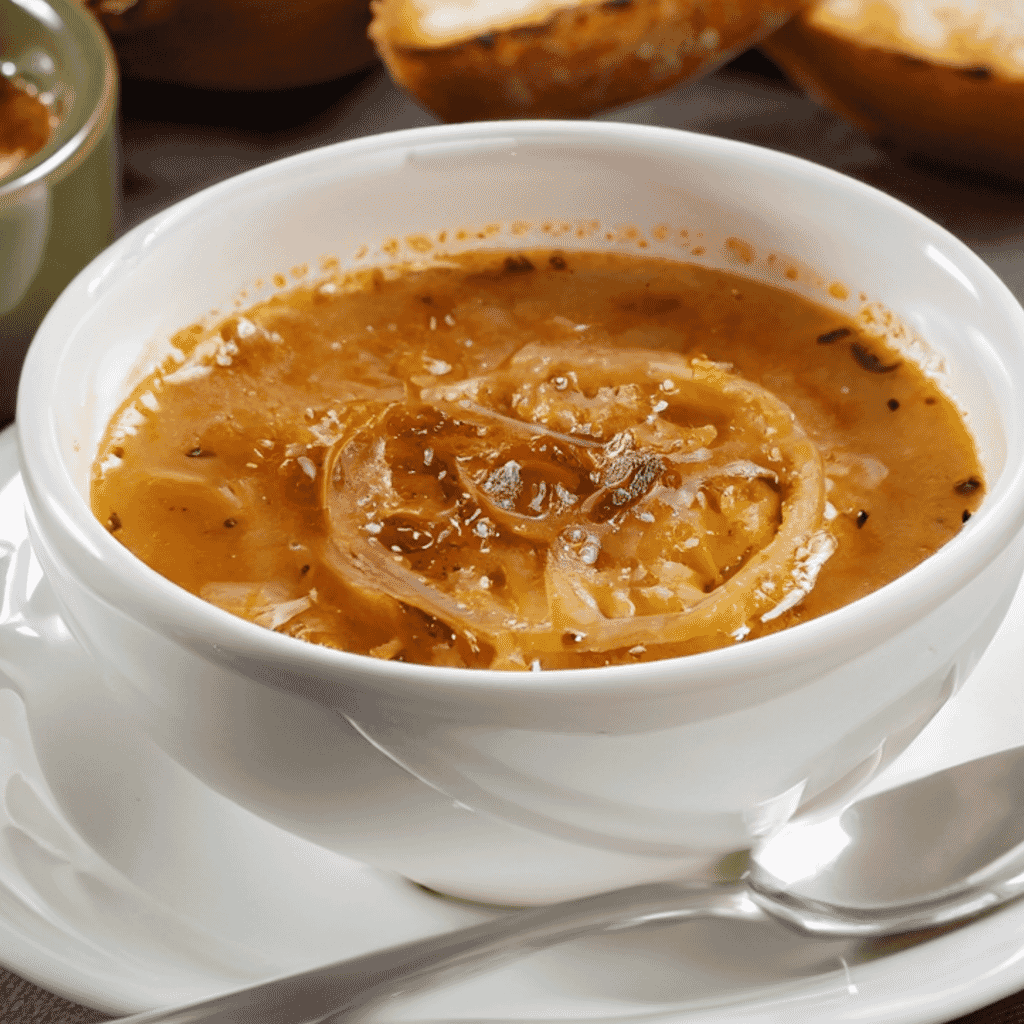
What Can Be Done With Leftover Soup?
Leftover French Onion Soup can be reheated and enjoyed as is, but if you’re interested in changing things up, here are a few creative ideas:
- French Onion Pasta: Toss the leftover soup with cooked pasta, top with extra cheese, and bake until bubbly for a comforting pasta bake.
- French Onion Dip: Reduce the soup on the stove until most liquid evaporates. Combine with cream cheese for a flavorful dip for chips or veggies.
- Savory French Onion Bread Pudding: Replace the milk or cream in a bread pudding recipe with equal soup. Add sautéed vegetables or cooked meat if desired.
- French Onion Risotto: Use the leftover soup instead of some of the broth in a risotto recipe. The onions and cheese will add extraordinary flavor to the risotto.
- Sauce for Protein: Reduce the soup until thick and use it as a sauce for grilled or roasted meats.
- French Onion Grilled Cheese: Use the onions and cheese from the soup as a filling for a grilled cheese sandwich. You can dip the sandwich in the leftover broth.
- Stuffed Vegetables: Use the soup to cook rice or quinoa, then use the mixture to stuff vegetables like bell peppers or zucchini.
Tips
- Caramelization is Key: Take your time when caramelizing the onions. Low and slow is the way to go. This process can take up to 45 minutes to achieve that rich, deep flavor. Don’t rush it!
- Use the Right Onions:After the onions have caramelized, deglaze the pan with a splash of dry white wine like Chardonnay or Sauvignon Blanc. This adds acidity and depth to the soup.
- Add a Splash of Wine: After the onions have caramelized, deglaze the pan with a splash of dry white wine like Chardonnay or Sauvignon Blanc. This adds acidity and depth to the soup.
- Homemade Stock: If possible, use homemade beef broth or stock instead of store-bought. It will elevate the flavor of the soup significantly. If you’re vegetarian, you can use a good quality vegetable broth.
- Fresh Herbs: Tie a bouquet garni of fresh thyme, bay leaves, and parsley stems with kitchen twine and add it to the soup while it simmers. This will infuse the broth with herbaceous flavors.
- Season Wisely:Remember that the broth will concentrate as it simmers, so be cautious with salt early on. You can always add more later if needed.
- Toast the Bread and Cheese Separately:Toast your baguette slices in the oven separately from the cheese. This prevents the cheese from melting too quickly and allows the bread to maintain its texture in the soup.
Nutrition Table
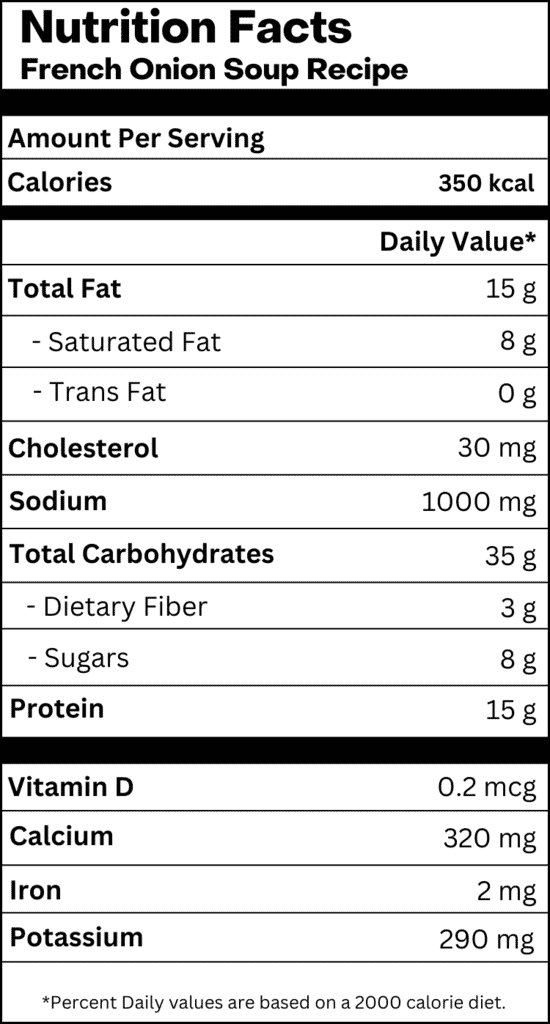
- How To Make Butternut Squash Soup Recipe – Easy And Delicious - February 13, 2024
- Perfect Chinese Chicken Soup Recipe – A Delightful Feast - October 3, 2023
- Easy Red Pepper Soup Recipe (Sweet-Mild Flavors) - October 3, 2023


A bowl of this French Onion Soup, a good book, and a rainy day—perfection!
This French Onion Soup recipe is my family favorite!
Surprisingly delicious and satisfying!